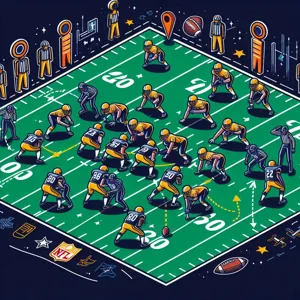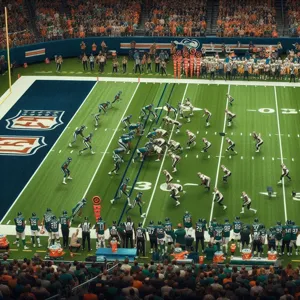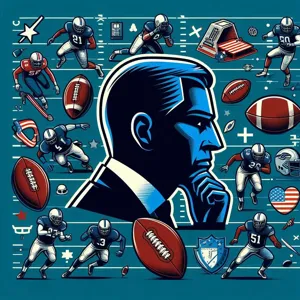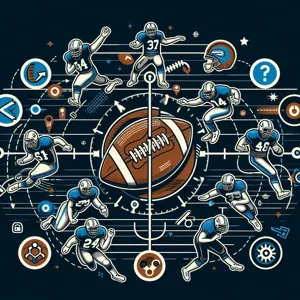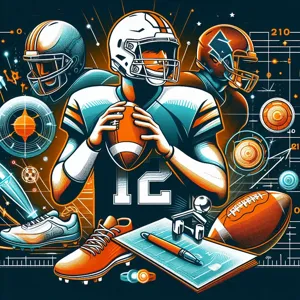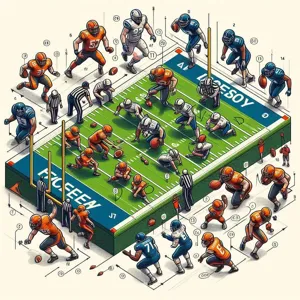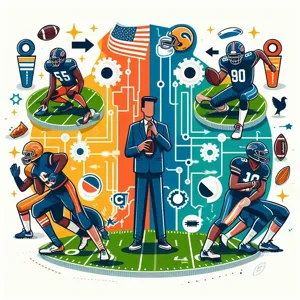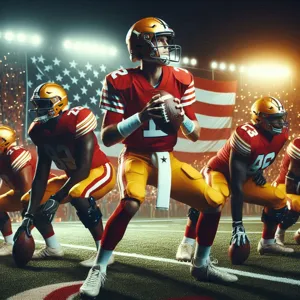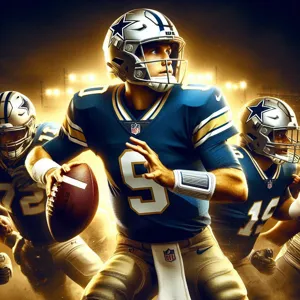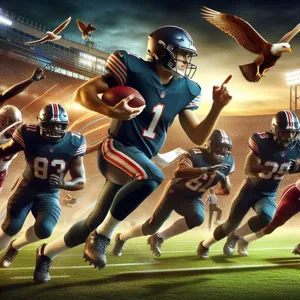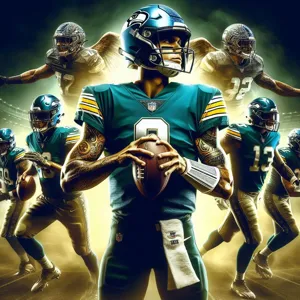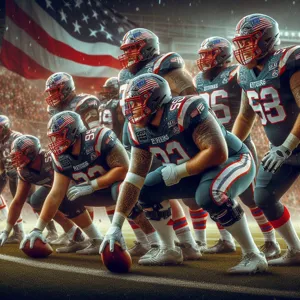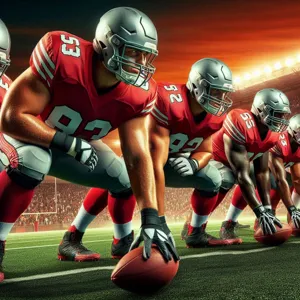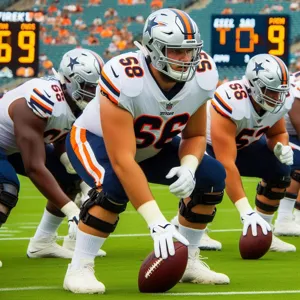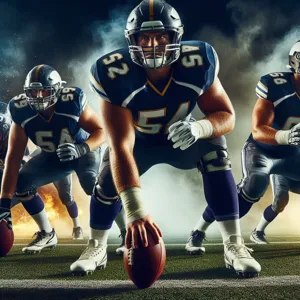In the high-octane world of the NFL, where every snap can redefine a player’s career, quarterbacks stand as both the leaders and the targets on the field.
As the linchpins of their teams, these athletes face intense physical demands, making them susceptible to a range of injuries that can sideline even the most talented stars. From the relentless pressure of defensive linemen to the wear and tear of a grueling season, quarterback pain is a reality that looms large in professional football. In this blog post, we will delve into the most common injuries that plague NFL quarterbacks, exploring the causes, implications, and recovery processes associated with these ailments. Whether you’re a die-hard football fan or a casual observer, understanding the physical challenges faced by these elite athletes will deepen your appreciation for their resilience and dedication to the game. Join us as we uncover the injuries that can hinder performance and alter the trajectory of a quarterback’s career.
1. Introduction to Quarterback Injuries in the NFL
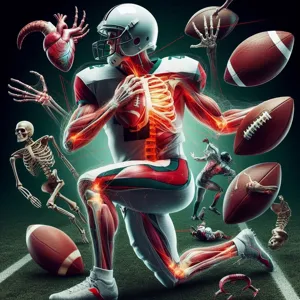
In the high-stakes world of the NFL, quarterbacks are often dubbed the “field generals,” tasked with leading their teams to victory while facing an array of physical challenges. These elite athletes are the backbone of their offenses, responsible for making split-second decisions, executing complex plays, and taking hits from towering defenders. Yet, the very nature of their role exposes them to a unique set of injuries that can sideline them for weeks or even an entire season.
In this section, we’ll delve into the most common injuries facing quarterbacks, exploring how the rigors of the game take a toll on their bodies. From shoulder injuries, which can severely impact a quarterback’s throwing ability, to knee injuries that can alter mobility and agility, we’ll uncover the reasons behind these ailments and the long-term effects they may have on a player’s career. Understanding these injuries is crucial not only for fans but also for coaches, trainers, and aspiring quarterbacks who wish to grasp the physical demands of the position.
As we navigate through the landscape of quarterback injuries, we will highlight notable cases from the league’s history, showcasing how some of the game’s greatest have battled through adversity. Injuries are an unfortunate reality in football, but they also reveal the resilience and determination that define the spirit of the NFL. Join us as we explore the most pressing concerns for quarterbacks on the field and what these injuries mean for their teams—and their futures.
2. The Anatomy of a Quarterback: Vulnerable Areas
The quarterback position is often regarded as one of the most demanding roles in the NFL, requiring a unique blend of physical prowess, mental acuity, and strategic foresight. However, this high-pressure position also places immense strain on the body, particularly in several vulnerable areas that are susceptible to injury. Understanding the anatomy of a quarterback can shed light on why certain injuries are so prevalent among these athletic giants.
**Shoulders:** The shoulders are perhaps the most crucial and vulnerable area for quarterbacks. As they execute powerful throws and absorb hits from oncoming defenders, the rotator cuff, which stabilizes the shoulder joint, is prone to strain and tears. Injuries such as shoulder impingement or labrum tears can sideline quarterbacks for weeks, if not months, impacting their ability to perform.
**Knees:** Quarterbacks are often targets for rushing defenders, making their knees susceptible to injuries such as sprains and tears of the ligaments. The anterior cruciate ligament (ACL) and the medial collateral ligament (MCL) are particularly vulnerable, and a knee injury can drastically alter a quarterback’s mobility and game performance.
**Ankles:** The rapid changes in direction and the need for agility place significant stress on a quarterback’s ankles. Ankle sprains are common, as are fractures that can occur when a quarterback is tackled or forced to scramble under pressure. These injuries can not only affect a quarterback’s ability to plant their foot while throwing but also hinder their ability to evade defenders.
**Backs:** The lower back is another area of concern, as quarterbacks frequently endure the impact of tackles and the strain of throwing motions. Conditions such as herniated discs or muscle strains can lead to chronic pain, impacting a quarterback’s overall effectiveness on the field.
**Concussions:** While not specific to any one body part, concussions remain a critical concern for quarterbacks. As they are often the focus of defensive aggression, the risk of head injuries is heightened. A concussion can not only sideline a player but also have long-term implications for their health and career.
Understanding these vulnerable areas is essential for both players and coaches, as it underscores the importance of injury prevention strategies, strength training, and recovery protocols. With the right approach, quarterbacks can better safeguard their bodies against the rigors of the game, allowing them to focus on what they do best: leading their teams to victory.
3. Common Injuries: Overview and Statistics
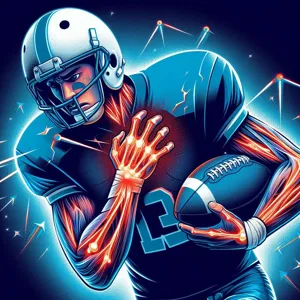
When it comes to the NFL, the quarterback position is often heralded as one of the most demanding and high-pressure roles on the field. With the game’s fast pace and physicality, it’s no surprise that quarterbacks frequently face a range of injuries that can sideline them for weeks or even months. An overview of the most common injuries reveals a mosaic of challenges that these athletes contend with regularly.
One of the most prevalent injuries among quarterbacks is the shoulder injury, which accounts for nearly 25% of all quarterback-related injuries. This can encompass everything from rotator cuff strains to labrum tears, often resulting from the repetitive throwing motion and the impact sustained during tackles. Statistics show that quarterbacks who suffer shoulder injuries may miss an average of 4 to 6 games, significantly impacting their teams’ performance.
Another common affliction is the knee injury, which includes sprains, tears, and the dreaded ACL injuries. These injuries can occur during scrambles or when a quarterback is sacked. Notably, knee injuries can lead to lengthy rehabilitation periods, often extending beyond a season, as seen with prominent players like Carson Wentz and Andrew Luck, who have both faced significant knee challenges in their careers.
In addition to shoulder and knee injuries, ankle sprains are also commonplace, arising from awkward landings or being hit while throwing. While these injuries are often less severe, they can still hinder a quarterback’s mobility and ability to perform at their best.
Understanding these statistics and common injuries is vital, not only for fans and analysts but for the players themselves, as they navigate the rigors of a grueling season. The physical toll of the game underscores the importance of injury prevention strategies and recovery protocols, ensuring these athletes can return to the field and continue showcasing their incredible talents.
4. Shoulder Injuries: Rotator Cuff Tears and Sprains
Shoulder Injuries: Rotator Cuff Tears and Sprains
The shoulder is a quarterback’s lifeline, pivotal for executing powerful throws and maintaining accuracy under pressure. However, the anatomy of the shoulder—while remarkably flexible—is also susceptible to a range of injuries, with rotator cuff tears and sprains being among the most common afflictions faced by NFL quarterbacks.
The rotator cuff is a group of four muscles and tendons that stabilize the shoulder joint and facilitate its wide range of motion. In the high-stakes environment of the NFL, where quarterbacks are often subjected to immense physical stress, these muscles can become strained or torn. A rotator cuff tear can occur during a particularly forceful throw, a fall, or even as a result of repetitive motion over the course of a demanding season. Symptoms often include a deep, aching pain in the shoulder, weakness in the arm, and difficulty lifting the ball for that perfect spiral pass.
Sprains, on the other hand, involve the overstretching or tearing of the ligaments around the shoulder. These injuries can occur during tackles, when a quarterback is sacked, or as a result of awkward landings. The pain from a shoulder sprain can be immediate and debilitating, often accompanied by swelling and restricted mobility.
Rehabilitation for these injuries can be extensive, often involving physical therapy to regain strength and flexibility. In some cases, surgical intervention may be necessary, particularly for severe tears. These injuries not only sideline players for weeks at a time but can also significantly impact the trajectory of a player’s career. The quest for recovery is a grueling one, as quarterbacks must not only heal their physical wounds but also regain the confidence to throw under pressure, knowing that the fate of the game—and their team—often rests on their shoulders.
5. Elbow Injuries: UCL Tears and Tendonitis
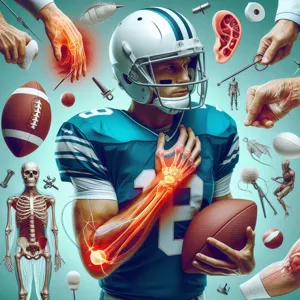
Elbow injuries are becoming increasingly prevalent among NFL quarterbacks, often leading to significant time on the sidelines and impacting a player’s performance and longevity in the league. Among the most common elbow ailments are UCL (ulnar collateral ligament) tears and tendonitis, both of which can transform a star quarterback’s career trajectory.
The UCL is a critical ligament that provides stability to the elbow, especially during the high-velocity throwing motion that quarterbacks are known for. When this ligament sustains a tear, it can result in severe pain and a loss of throwing accuracy. Recovery often necessitates Tommy John surgery, a procedure that has become almost synonymous with the rehabilitation of elite pitchers in baseball but is increasingly common for football players as well. The recovery process is lengthy, typically taking anywhere from six months to a year, which can be devastating for a quarterback working to maintain their starting position.
On the other hand, elbow tendonitis, often referred to as “golfer’s elbow” or “tennis elbow,” can also plague quarterbacks. This inflammation of the tendons around the elbow can stem from repetitive stress and overuse, both of which are inevitable in the demanding environment of the NFL. Symptoms include pain and tenderness on the inner side of the elbow, which can lead to decreased throwing power and accuracy. While tendonitis may not always require surgery, it often requires a comprehensive rehabilitation program, including physical therapy, rest, and sometimes corticosteroid injections to manage inflammation and pain.
Both UCL tears and tendonitis underscore the physical toll that the quarterback position demands. With the pressure to perform at an elite level week in and week out, maintaining elbow health is paramount. For fans, these injuries serve as a sobering reminder of the fragility of athletic prowess, as the future of a promising career can hinge on the health of a single ligament or tendon. As NFL teams invest in advanced training regimens and medical technologies, the hope remains that quarterbacks can minimize these risks and continue to dazzle fans with their incredible skills on the field.
6. Wrist and Hand Injuries: Fractures and Sprains
Wrist and hand injuries are an all-too-common occurrence for NFL quarterbacks, whose reliance on precise throwing mechanics leaves these critical areas vulnerable to trauma. Fractures and sprains can sideline even the most talented players, drastically affecting their performance and the overall dynamics of the team.
The wrist, composed of multiple small bones and joints, is particularly susceptible to injury during a game. A quarterback may suffer a fracture when tackling defenders or when attempting to throw the ball under duress, leading to a painful break that can take weeks or even months to heal. On the other hand, sprains occur when the ligaments that support the wrist or thumb are overstretched or torn. This often happens during high-impact falls or when a player’s hand collides with another player’s helmet or shoulder pad while throwing.
Consider the case of a quarterback whose success hinges on their ability to throw with precision and velocity. A sprained wrist can diminish grip strength and flexibility, making it challenging to release the ball accurately. Even a minor injury can lead to hesitation and inconsistency in performance, which can be detrimental in high-stakes games.
Rehabilitation is crucial for these injuries, often involving a combination of rest, physical therapy, and in some cases, surgery. Players must work diligently to regain their strength and range of motion, as their hand and wrist are integral to their role on the field. The mental aspect of recovery is equally important — quarterbacks must overcome the fear of re-injury, which can impact their confidence and playing style.
As fans, we see the glitz and glamour of NFL Sundays, but behind the scenes, the struggle with wrist and hand injuries is a stark reminder of the physical toll the game takes on these elite athletes. Ensuring proper conditioning, utilizing protective gear, and employing advanced training techniques are essential steps in minimizing the risk of these injuries, allowing quarterbacks to focus on what they do best: leading their team to victory.
7. Concussions: The Hidden Danger for Quarterbacks
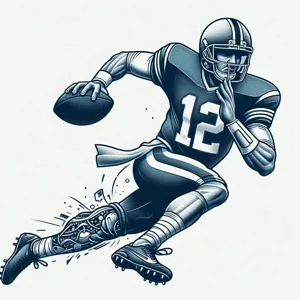
Concussions are often referred to as the “invisible injury” in the NFL, and for quarterbacks, they pose a particularly insidious threat. As the leaders on the field, quarterbacks are not only responsible for orchestrating plays but also serve as prime targets for aggressive defensive strategies. The hard hits and rapid impacts that are part of the game can result in concussions, which may not always present immediate symptoms but can have long-term effects on a player’s health and performance.
Recent studies have highlighted the frequency and severity of concussions in football, with quarterbacks facing a unique set of challenges. Unlike players in other positions, they are often required to maintain their composure and decision-making abilities while under duress, a task made nearly impossible when experiencing the aftereffects of a concussion. Symptoms such as confusion, dizziness, and memory issues can severely impair their ability to read defenses and make split-second decisions, which are crucial for success.
Moreover, the fear of re-injury plays a significant psychological role. Quarterbacks who have suffered a concussion may hesitate during plays, leading to slower reactions and a higher risk of being hit again. The NFL has made strides in improving concussion protocols, including mandatory evaluations and stricter return-to-play guidelines, yet the risk remains ever-present. For quarterbacks, the path to recovery can be complex; they must not only heal physically but also regain the mental sharpness necessary to perform at the highest level.
As awareness around concussions grows, so does the emphasis on player safety. Coaches, teams, and medical staff are increasingly focused on preventing these injuries and ensuring that quarterbacks receive the appropriate care and time off to recover fully. Understanding the hidden dangers of concussions is essential in protecting the future of the game and its most vital players.
8. Lower Body Injuries: Hip, Knee, and Ankle Issues
Lower body injuries—particularly those affecting the hip, knee, and ankle—are an all-too-frequent concern for NFL quarterbacks. These injuries not only sideline talented players but can also dramatically shift the dynamics of a game, impacting the entire season for both the athlete and their team.
The hip, often referred to as the body’s powerhouse, plays a crucial role in a quarterback’s ability to generate power and maintain stability during throws. Injuries such as hip flexor strains or labral tears can severely limit a player’s range of motion, affecting their throwing mechanics and overall performance. A quarterback with compromised hip function may struggle to execute deep passes or evade defenders, making it a critical area of concern.
Knee injuries, particularly those involving the anterior cruciate ligament (ACL) or meniscus, are another common plight. The quick, explosive movements required during gameplay place immense stress on the knees. A torn ACL can not only sideline a player for an entire season but can also lead to long-term complications, diminishing the player’s agility and speed. The recovery process is arduous, often requiring extensive rehabilitation and physical therapy, with some players never returning to their pre-injury form.
Ankle injuries, such as sprains or fractures, can occur from awkward landings or sudden changes in direction. These injuries can range from mild to severe, with high ankle sprains being particularly troublesome for quarterbacks. Unlike regular ankle sprains that can heal relatively quickly, high ankle sprains can linger, affecting a player’s ability to cut and pivot effectively. Given that quarterbacks often need to evade rushing defenders while maintaining their throwing stance, a compromised ankle can significantly hinder their effectiveness on the field.
The impact of lower body injuries extends beyond physical limitations; they can also take a psychological toll. Quarterbacks may develop a fear of re-injury, leading to hesitance in their movements and a decrease in confidence. As they grapple with the mental aspect of recovery, the pressures of performing at the highest level of professional football can heighten the stakes, making effective rehabilitation and support crucial for a successful comeback.
In a sport where every play counts and the competition is fierce, lower body injuries remain a formidable challenge for NFL quarterbacks, highlighting the importance of injury prevention strategies and effective treatment protocols to ensure these stars remain at the top of their game.
9. Recovery and Rehabilitation: The Road to Recovery
Recovery and rehabilitation are crucial in the journey back to the field for NFL quarterbacks who have faced injury. The intense physical demands of the game, combined with the high-pressure environment in which these athletes operate, make a comprehensive recovery plan essential for their return to peak performance.
When a quarterback suffers an injury, whether it’s a sprained ankle, torn ligament, or shoulder dislocation, the immediate response often involves thorough medical evaluations and imaging studies to determine the extent of the damage. Following the diagnosis, a tailored rehabilitation program is set in motion—a blend of physical therapy, strength training, and sometimes, advanced treatments like stem cell therapy or platelet-rich plasma (PRP) injections.
During the rehabilitation phase, athletes are not only focused on healing the injured area but also on maintaining their overall fitness. This involves engaging in low-impact exercises that keep their cardiovascular health in check while avoiding strain on the injured site. Physical therapists work closely with players, utilizing techniques such as manual therapy, ultrasound, and targeted exercises to restore mobility and strength.
Mental resilience is another vital component of recovery. Many quarterbacks face psychological hurdles as they work to regain their confidence on the field. Visualization techniques, mental conditioning, and support from sports psychologists can play a significant role in overcoming fear and anxiety surrounding reinjury.
As the quarterback progresses through rehabilitation, they often participate in modified training sessions to gradually reintroduce football-specific movements. This might include throwing drills, footwork exercises, and agility training, all while under the watchful eye of coaches and trainers. This phased approach ensures that once they return to full practice, they are not only physically prepared but also mentally ready to lead their team effectively.
Ultimately, the road to recovery for NFL quarterbacks is a testament to their dedication and resilience. With a combination of expert medical care, physical therapy, and mental fortitude, these athletes strive to reclaim their place on the field, proving that even after a setback, they can rise stronger than ever.
10. Prevention Strategies: Keeping Quarterbacks Healthy
In the high-octane world of the NFL, where every pass can determine a game’s outcome, protecting quarterbacks from injury is paramount. With the physical demands of the position, implementing effective prevention strategies can significantly extend a player’s career and enhance their performance on the field. Here are some key approaches to keeping quarterbacks healthy and ready to lead their teams to victory.
**1. Comprehensive Strength Training:** A well-rounded strength training program is essential for quarterbacks. Focusing on core stability, shoulder strength, and leg power helps build a solid foundation. Exercises like planks, medicine ball throws, and squats can fortify the muscles that support throwing mechanics and reduce the risk of injury.
**2. Flexibility and Mobility Routines:** Maintaining flexibility is crucial for quarterbacks, who often need to throw from various angles and positions. Incorporating dynamic stretching and yoga into their routines can enhance mobility, allowing for quicker adjustments and better overall performance.
**3. Proper Throwing Mechanics:** Coaches should emphasize correct throwing mechanics from the very beginning. By developing proper form, quarterbacks can minimize undue stress on their arms and shoulders. Regular video analysis can help identify and correct any mechanical flaws that may lead to injury.
**4. Regular Recovery Protocols:** Recovery is just as important as training. Implementing regular recovery protocols, such as ice baths, massage therapy, and active recovery days, can help alleviate muscle soreness and prevent long-term injuries. Incorporating practices like foam rolling and stretching sessions into their routines can also aid in recovery.
**5. Nutrition and Hydration:** A quarterback’s diet plays a significant role in their overall health and performance. Fueling the body with the right nutrients and staying hydrated helps maintain energy levels and supports muscle recovery. Tailoring meal plans to meet their specific needs can make a world of difference.
**6. Smart Game Strategies:** Coaches should design offensive plays that allow quarterbacks to make quick decisions and minimize the time spent in the pocket. Utilizing short passes or play-action can reduce the risk of exposure to heavy hits and lower the likelihood of injuries.
By prioritizing these prevention strategies, teams can safeguard their quarterbacks from the wear and tear of the game, ensuring they remain healthy and effective leaders on the field. With a proactive approach to injury prevention, NFL stars can continue to shine brightly, showcasing their talents for seasons to come.
11. Impact of Injuries on Team Performance
In the high-stakes world of the NFL, the impact of injuries extends far beyond the individual player; it reverberates throughout the entire team, influencing strategy, morale, and performance on the field. When a star quarterback, for instance, suffers a significant injury, the team’s dynamics can shift dramatically. The quarterback is often the linchpin of the offense, responsible for not only executing plays but also for rallying the team and instilling confidence.
The immediate aftermath of an injury can be chaotic. Coaches must scramble to adjust their game plans, often relying on backup quarterbacks who may lack the same level of experience or familiarity with the starting lineup. This can lead to a decrease in offensive efficiency, as timing and chemistry that usually develop through practice become disrupted. Defenses may also begin to exploit the weaknesses introduced by a less experienced signal-caller, making it even harder for the team to compete at a high level.
Furthermore, the emotional toll on both players and coaches cannot be underestimated. The loss of a key player can dampen team morale, creating a ripple effect that may lead to decreased performance across the board. The remaining players may feel the pressure to step up, which can lead to mistakes as they try to compensate for the absence of their star.
Long-term injuries can also have broader implications, affecting the team’s playoff chances and future seasons. Teams that consistently lose key players due to injury may find themselves in a cycle of rebuilding, struggling to compete against healthier rosters. Additionally, the financial ramifications of injuries can be immense, as teams navigate contracts, salary caps, and the potential need to find replacements in free agency or the draft.
In sum, injuries in the NFL are not just a concern for the affected players; they are a complex challenge that can dramatically alter a team’s trajectory. As teams look to build rosters that can withstand the rigors of a grueling season, understanding the impact of injuries on team performance becomes crucial for success on the field.
12. Case Studies: Notable Injuries of NFL Quarterbacks
Quarterbacks are often seen as the backbone of their teams, orchestrating plays and leading their squads to victory. However, their high-stakes role also places them at significant risk for injuries, which can be both career-altering and game-changing. In this section, we delve into notable case studies of injuries that have sidelined some of the NFL’s biggest stars, offering insights into both the physical and mental toll these injuries can take.
One of the most infamous cases is that of **Tom Brady**, who in 2008 suffered a devastating ACL tear in his left knee during the season opener. This injury not only ended his season but also raised questions about the future of one of the league’s most celebrated quarterbacks. Brady’s remarkable recovery and subsequent return to form serve as a testament to his resilience, as he went on to win multiple Super Bowls post-injury, forever altering the narrative around athlete rehabilitation.
Similarly, **Carson Wentz**, once touted as a franchise quarterback for the Philadelphia Eagles, faced a series of injuries that culminated in a torn ACL in 2017. This injury occurred during a pivotal point in the season when the Eagles were on the verge of a playoff berth. Wentz’s injury not only impacted his career trajectory but also significantly affected the team dynamics, leading to backup Nick Foles stepping in and ultimately guiding the Eagles to their first Super Bowl victory. Wentz’s struggle with injuries emphasizes the unpredictable nature of the sport and the pressure on quarterbacks to perform at an elite level despite physical setbacks.
Another notable injury is that of **Andrew Luck**, who faced a myriad of issues throughout his career, including shoulder injuries that plagued him for years. His eventual decision to retire in 2019 came as a shock to fans and players alike, highlighting the intense physical and emotional strain that can accompany chronic injuries. Luck’s situation serves as a cautionary tale about the long-term consequences of playing through pain and the importance of prioritizing health over the game.
These case studies illustrate the precarious nature of a quarterback’s career in the NFL, where every snap can lead to a life-changing injury. They remind us that behind the statistics and accolades, these athletes are human, grappling with both the physical demands of their position and the mental resilience required to return to the game. As we continue to examine quarterback injuries, it becomes clear that understanding their impact goes beyond the field, resonating with fans and aspiring athletes alike.
13. The Role of Sports Medicine in Injury Management
In the high-octane world of the NFL, where every play can mean the difference between victory and defeat, the role of sports medicine is pivotal in managing quarterback injuries. These athletes push their bodies to the limit, often facing a barrage of injuries that can sideline them for weeks or even months. Sports medicine professionals play a crucial part in their recovery, employing a multifaceted approach that combines prevention, diagnosis, treatment, and rehabilitation.
At the forefront is injury prevention. Sports medicine teams work closely with quarterbacks to develop tailored training regimens that enhance strength, flexibility, and endurance—key factors in minimizing the risk of injuries like shoulder sprains, ACL tears, and concussions. They utilize advanced technologies, such as motion analysis and biomechanical assessments, to identify potential weaknesses in an athlete’s mechanics, allowing for targeted interventions.
When injuries do occur, sports medicine professionals spring into action. Their expertise in diagnosing conditions is vital, as they often conduct thorough examinations and imaging studies to pinpoint the exact nature of the injury. Once diagnosed, a personalized treatment plan is created, which may include physical therapy, medication, or even surgical interventions when necessary. For example, a quarterback dealing with a rotator cuff tear might undergo a specific rehabilitation program that focuses on restoring mobility and strength while avoiding further damage.
Rehabilitation is where sports medicine truly shines. The journey back to the field is not just about physical healing but also mental fortitude. Sports medicine specialists provide not only physical therapies but also psychological support, helping athletes cope with the emotional challenges of injury recovery. This holistic approach ensures that when quarterbacks return to the game, they are not just physically ready but also mentally prepared to face the rigorous demands of their position.
Ultimately, the role of sports medicine in managing quarterback injuries is indispensable. It encompasses a wide range of services aimed at ensuring players can perform at their best, recover from injuries effectively, and prolong their careers in a sport that is as demanding as it is exhilarating. As the game continues to evolve, the partnership between athletes and sports medicine professionals will remain a cornerstone of success on the field.
14. Future Trends in Injury Prevention and Treatment
As the NFL continues to evolve, so too does the approach to injury prevention and treatment, particularly for quarterbacks who endure a unique set of physical challenges. The future of this field is promising, with a multi-faceted focus on technology, training methodologies, and holistic health approaches shaping the landscape.
One trend gaining traction is the use of advanced wearable technology. Devices that monitor biomechanics in real-time are becoming invaluable tools for quarterbacks during practices and games. These wearables can track everything from throwing mechanics to the player’s strain levels, enabling coaches and trainers to tailor training regimens that minimize injury risk while enhancing performance. By identifying subtle changes in movement patterns, teams can intervene before a minor issue escalates into a significant injury.
In addition to technology, a growing emphasis on personalized training programs is taking root. Teams are increasingly hiring specialists in sports science and rehabilitation to develop customized programs that address the specific needs and physical conditions of each quarterback. These programs often include a combination of strength training, flexibility exercises, and recovery protocols designed to fortify the body against common injuries such as shoulder strains, knee injuries, and concussions.
Moreover, nutrition and mental health are gaining recognition as integral components of injury prevention. Players are being educated about the importance of proper nutrition in fueling their bodies for optimal performance and recovery. Simultaneously, mental health resources are becoming more accessible, with teams recognizing that a quarterback’s mental state can significantly impact their physical performance and vulnerability to injury.
Lastly, collaboration between medical professionals and coaching staff is more crucial than ever. Establishing a culture where injuries are openly discussed and comprehensively managed leads to better outcomes for players. As more teams prioritize continuous education and innovation in injury management, the hope is that quarterbacks can enjoy longer, healthier careers, allowing them to shine on the field without the looming threat of injury.
As we look ahead, the marriage of technology, personalized care, and a holistic approach to health will undoubtedly shape the future of how the NFL protects its stars, ensuring that they remain not just players, but legends of the game.
15. Conclusion: The Importance of Understanding Quarterback Injuries
In conclusion, understanding quarterback injuries is crucial not only for coaches and trainers but also for fans and aspiring athletes alike. Quarterbacks are the linchpins of their teams, responsible for executing plays and leading their squads to victory. However, the intense physical demands placed on them can lead to a range of injuries that may sideline them for crucial games or even entire seasons.
By recognizing the common injuries faced by quarterbacks—such as sprains, fractures, and concussions—stakeholders can adopt preventive measures and better manage recovery processes. For coaches, this knowledge is essential in crafting training regimens that prioritize player safety while still enhancing performance. For fans, being informed about the health status of their favorite players adds depth to their understanding of the game and fosters empathy for the challenges these athletes face.
Moreover, the evolving landscape of sports medicine and rehabilitation offers promising advancements that can significantly impact recovery times and long-term health. As we continue to learn more about the physical toll of the game and the best practices for injury prevention, it becomes increasingly important to maintain an open dialogue within the football community. By prioritizing education and awareness around quarterback injuries, we can not only protect the players but also ensure the integrity and excitement of the game for years to come.
In conclusion, understanding the common injuries faced by NFL quarterbacks is crucial not only for fans but also for aspiring athletes and coaches. These elite players endure incredible physical demands, making them susceptible to a range of injuries that can impact their performance and careers. From shoulder strains to concussions, the toll of the game is undeniable. By highlighting these injuries, we hope to raise awareness about the importance of injury prevention, proper training, and recovery strategies in football. As the game continues to evolve, so too will the approaches to keeping these talented athletes on the field. Thank you for joining us on this deep dive into quarterback pain; may it serve as a reminder of the resilience and dedication required to excel in one of the toughest sports on the planet.

